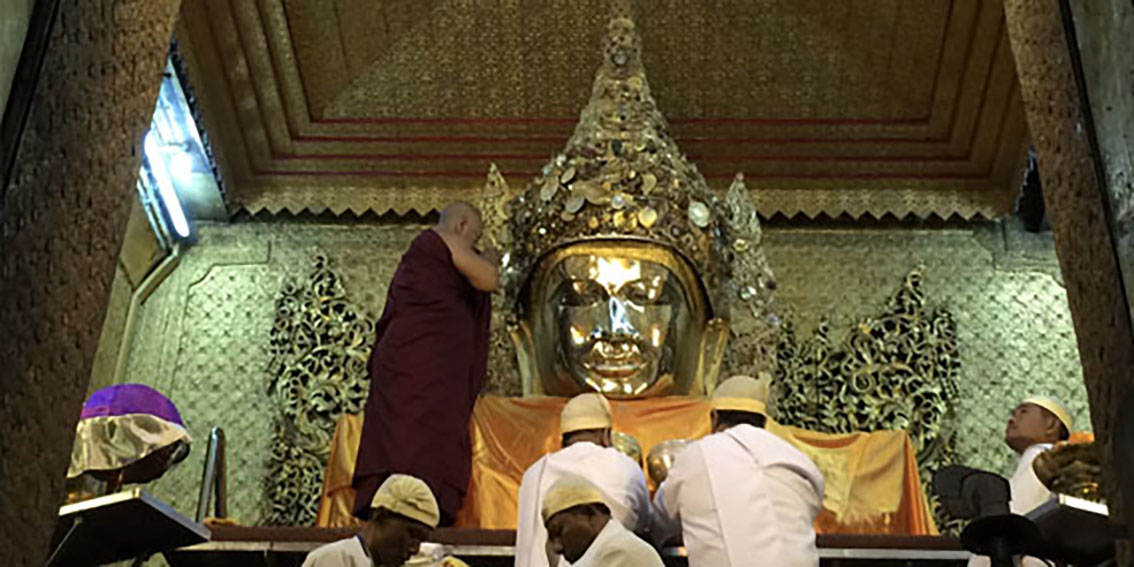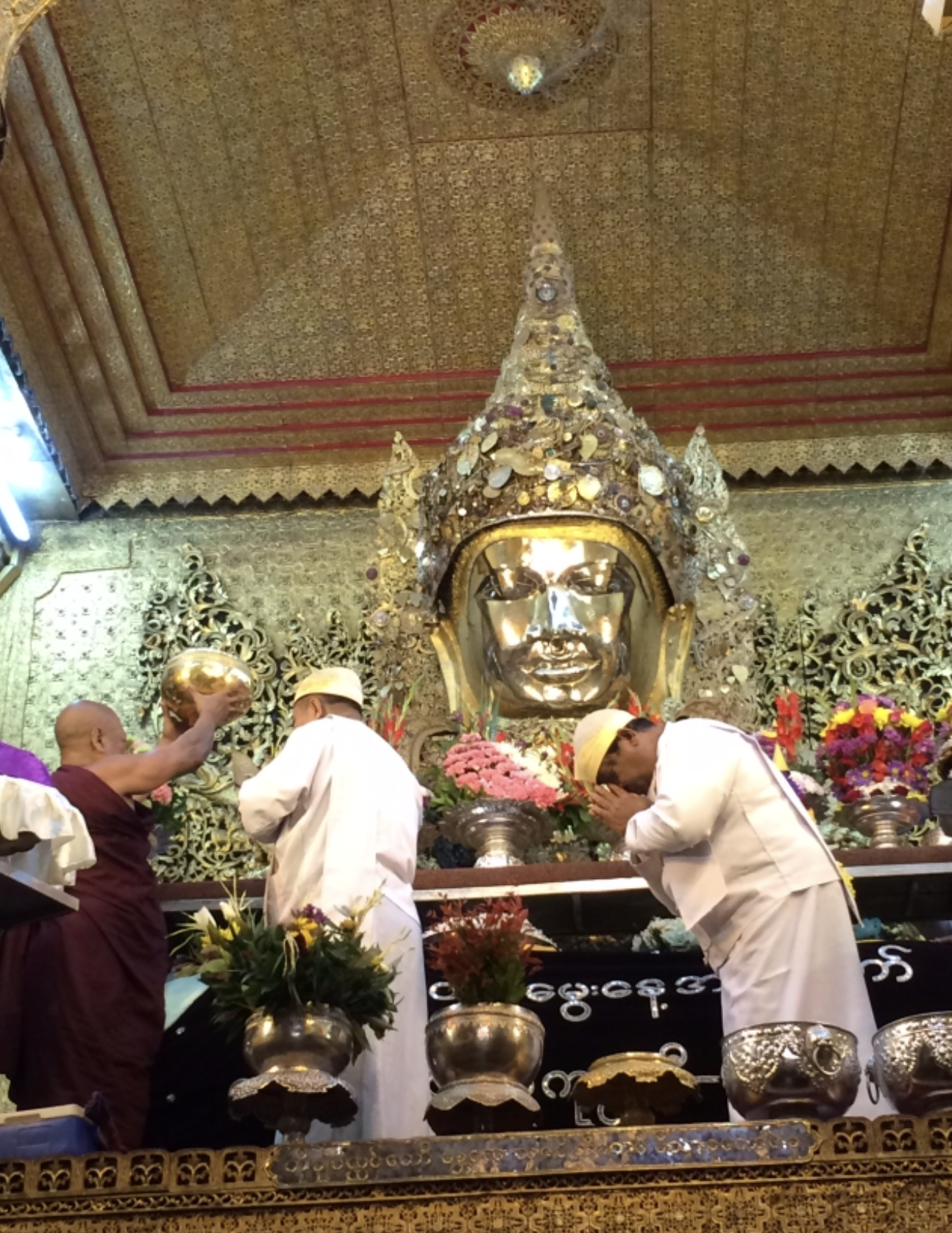
April 12, 2025
Mahamuni Temple (1785 onward) (Burmese: မဟာမုနိဘုရားကြီး)
The Mahamuni temple is the most important religious site in Mandalay, on par with the great Shwedagon of Yangon and the Golden Rock of Kyaikto. It is relatively new, created in 1785 by King Bodawpaya to house the Mahamuni, an image of the Buddha seized from Arakan in what is now western Myanmar’s Rakhine state. As the main object of devotion is the image itself, the temple’s architecture—while impressive—has always been secondary to the veneration of the image.

Creation of the Image and its Significance
The word “Mahamuni" literally means “Great Sage" and refers to the object’s legendary origins. It was supposedly created by the Buddha himself who magically flew during his lifetime to a Rakhine king named Chandra-suriya (or Sanda Thuriya). Chandra-suriya and his retinue quickly converted to the new faith, asking the Buddha to provide them with an image to venerate. Such was the Buddha’s authority that the gods themselves roused to the task, with the chief of the gods, Thagyamin, working hand-in-hand with a divine artisan named Vissakamma to fashion a suitable likeness. When the Buddha saw their work, he was well pleased but knew that such an image was ultimately lifeless and dead, a pale substitute for the living Buddha. The Buddha then breathed on the image, imbuing it with magical potency.
Emil Forchhammer, a late 19th-century archaeologist, translated what happened next from an Arakanese manuscript called the Sappadanapakarana (items in brackets are not part of the original):
“While the great teacher gazed upon the image it slowly rose as if possessed of life and stood in the attitude of welcoming his elder brother [Gautama, the historical Buddha]; and the Omniscient One [Gautama] stretched out his right hand, waved his hand, and said (to the image): ‘Younger brother, do not stand up. I shall enter nirvana in my eightieth year; but you, endowed with the supernatural powers of a Buddha, shall exist for 5,000 years, which I have prescribed to be the limit of my religion; you shall be the means of working the salvation of men and nats’. After delivering this prophecy the Blessed One continued: ‘In one of my former existences I was a king on the island of Cheduba. I broke the thigh-bone of a gardener and sliced off a piece of flesh from the back of a young prince; you (addressing the image) are my representative on earth and you shall suffer the results [consequences] of these two evil deeds’." (Forchhammer, pp. 4-5).
This passage is central to understanding the later history of the image, as it introduces several themes that underscore the value of the image to whoever possesses it. It also offers a metaphysical explanation of how the image has transformed over time from a “living likeness" of the Buddha into an apparently mute and lifeless relic.
First, the above episode shows that the Buddha endowed the image with life and addressed it as a “younger brother." This is meant to be taken quite literally: the Buddha duplicated himself in the same manner that he did at Srivasti, where he performed the “twin miracle," duplicating his body to disseminate the Law more widely among his disciples. The early legends claim that the original Mahamuni image was an exact likeness of the Buddha and could even speak and serve as counsel to King Chandrasurya and his successors. The living image also worked miracles from its place of honor in a purpose-built temple: birds refused to fly over it, and worshippers saw rays of light streaming from its features, whereas the presence of non-believers caused the rays to fade. Water used to clean the image’s head did not overflow any containers used to collect it and remained fresh throughout the year.
However, in creating the image, the Buddha also specified a limit to its powers: a mere 5,000 years, to coincide with a future era when the Buddha’s precepts have been all but forgotten, and the world has descended into ignorance. Simultaneously, the image is “winding down" as it is bearing the fruit of the negative karma the Buddha accrued in a past life when, as King of Cheduba, he injured a gardener and a young prince. This explains why the image gradually lost a measure of its power over the centuries. Schober notes that in a conversation with a trustee of the Mahamuni temple, the latter explained, “in the past, the image used to speak, but it fell silent" (Schober, p. 243). Though the image remains powerful, it is no longer the living twin it once was.
The fruit of negative karma also explains why the image has suffered the indignity of capture in battle and why it can be “injured," including sustaining damage in several late 19th century fires. Though fated to last 5,000 years, not all such years will be free of suffering.
Documented History of the Image
The history of the image for the next several thousand years after Chandra-suriya’s time is colorful, often involving faraway kings who tried but failed to seize the image by force, including King Anawratha of Pagan (r. 1044-1077). Some of these legends may reflect actual attempts by historical rulers to take the image, but it is not at all clear where myth ends, and history begins. Forchhammer seems to take at face value the local chronicles, which provide an implausibly early date of 789 when the image-house was recorded as being twice rebuilt. However, Donald Stadtner, one of the leading scholarly authorities of the present age, believes that the image’s historical origins likely date to the 14th century, though he concedes that “it is difficult to fix" (Stadtner, p. 262). He notes that the image was traditionally believed to hail from Dhanyawadi (Dhannavati), about 32 kilometers north-northwest of Mrauk-U in today’s Rakhine state, where the temple that used to house it still functions. Documentary evidence of the image’s existence comes into being in the mid-17th century when a Rakhine king re-enshrined the image in a local temple to replace an older building destroyed by fire. There is also an account by the Dutchman Wouter Schouten, who saw the image in 1660 or 1661.
The image’s modern and better-documented history comes into focus in the late 18th century during the rule of King Bodawpaya (r. 1782-1819), the sixth king of the Konbaung Dynasty. As a young ruler in the early 1780s, the King presided over a country that was at or near the height of its prosperity, having demonstrated its military supremacy (and therefore, legitimacy) by having finished off the venerable Ayutthayan Kingdom in Siam in 1767 while holding subsequent Qing Chinese excursions at bay. The confident king (who would later style himself as none other than Maitreya himself) turned his eyes to the Rakhine kingdom to the west. Although a fellow Buddhist neighbor, this would no more protect that kingdom than it did Ayutthaya, which was also staunchly Buddhist. Bodawpaya readied his armies and marched west into Rakhine in 1784, quickly seizing its capital at Mrauk-U. Along with wagonloads of plunder, including 20,000 captives, the King also came into the possession of the Mahamuni image.
Moving the image back to the capital at Amarapura (immediately north of the old capital, Ava, or Inwa), was a Herculean task, as the image weighed at least six and a half tons. It took at least a month for the statue to be moved across mountain passes and floated along waterways in its journey to the capital. It reached the shores of Amarapura on April 27, 1785, and traveled the final few kilometers to its current resting place over the following weeks, arriving at its present home on May 7, 1785.
The Mahamuni Temple
King Bodawpaya built a shelter to protect the image, comprising a seven-level pyat-that shrine that included gilded walls with mirrored glass. Construction continued throughout his reign and into the 19th century, with the original tower replaced as early as 1807. Fire was a constant menace, and a small conflagration in 1879 damaged the temple’s west side. Disaster struck just 5 years later when the temple and its corridors (including 252 gilded pillars) were consumed by fire in April 1884. Although the main image escaped destruction, so much melted gold was recovered that artisans fashioned the mass into a new ‘robe’ for the image. Reconstruction proceeded quickly during the reign of King Thibaw (r. 1878-1885). Though the state’s finances were much constricted by the loss of lower Burma to the British Empire, the king donated many sumptuous luxuries for the temple, including numerous diamonds, emeralds, and pearls to create a crown and ‘umbrella’ over the image, which were well-received.
The Burmese-led reconstruction came to an abrupt end with the entrance of British forces into the city, which they seized in November 1885 during the nation’s third war with the Burmese. The British occupiers were intent to stay and perhaps saw merit in associating themselves with the temple’s wholesale reconstruction. The occupiers set up a meeting in 1891 to determine the scope of reconstruction, eventually settling on a design proposal by Hoyne Fox, a British engineer. Fox’s plan retained the seven-story pyat-that to crown the image and Westernized the temple by adding European-style arcades. To maximize the viewing area, the plan created four large chambers facing the four cardinal directions, each facing inward toward one side of the seated image, which faces east. This axiality is further reinforced by long covered corridors that extend the four directions, with the longest facing toward the east. Today, these corridors are crowded on either side by souvenir and memorabilia sellers, while large televisions mounted on the ceilings display continuous live views of the central image.
Apart from the main image, a number of other statues are on site. Among these are six bronze figures that were probably first cast in Angkor in the 12th or 13th centuries. These were captured by Siamese armies in the 15th century and brought to Ayutthaya, probably following the seizure of the Angkor Kingdom’s capital and its Royal Palace. They were later taken to Burma by King Bayinnaung in 1569, where they subsequently made their way to Mrauk-U after being captured and recaptured multiple times. The images—now heavily remodeled to repair the damage done over the centuries—are stored on-site and believed by pilgrims to heal various ailments.
